The pub is Poole’s former main library, built in the late 19th century on a site donated by lord of the manor, Lord Wimborne. The Free Library was opened by the earl of Ilchester, Lord Lieutenant of Dorset and Poole, while the Schools of Science and Art were opened by Lord Wimborne. He also headed the subscription list to equip the new building, with his mother, Lady Charlotte, also contributing.
A print and text about Lord Wimborne.

The text read: Sir Ivor Bertie Guest was born on 29 August 1835, one of ten children, he succeeded to the title Lord Wimborne in 1852. His father was the first Baron Wimborne, an iron master from Dowlais. He owned Guest Keen and Nettlefold a company which supplied iron for railways, which later was managed by Ivor’s mother Lady Charlotte after his father’s death.
During the late 19th century the Manor of Canford changed hands to the Guest family. Sir Charles Barry (the architect who designed the Houses of Parliament) was commissioned to refashion the new family home. Lord Wimborne was married on the 25 May 1868 to Lady Cornelia Henriette Maria Spencer-Churchill who was very involved in improving schemes and housing in the town.
Lord Wimborne owned a vast amount of land in Poole, he proposed to build a new hospital to mark the Queen’s Golden Jubilee in 1887. Wimborne’s proposal was turned down, however, he sold the council a piece of his land to build J Norton’s Public Library.
Lord Wimborne had 5 sons and 4 daughters, he died in 1914 and Ivor Churchill, his son, succeeded as the 3rd Baron of Wimborne. The current Viscount Wimborne – Ivor Mervyn Vigors Guest, born in 1968, now lives in France.
A photograph of Lord Wimborne, and a copy of his invite to Guildhall to celebrate the opening of the public library.
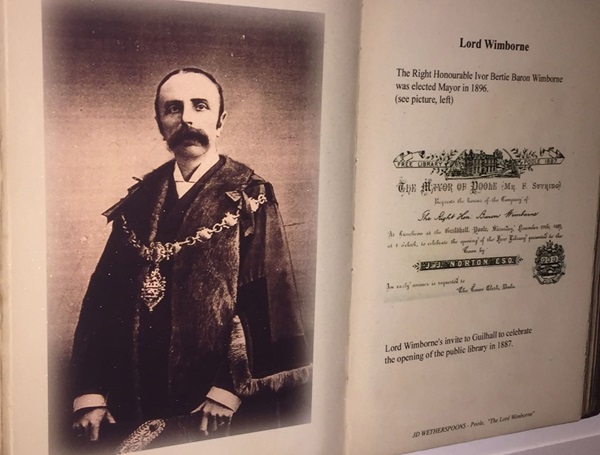
An illustration of Poole free library and photograph of Lord Wimborne.
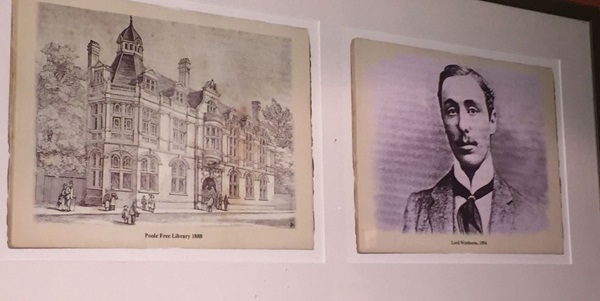
Text about Poole Quay.
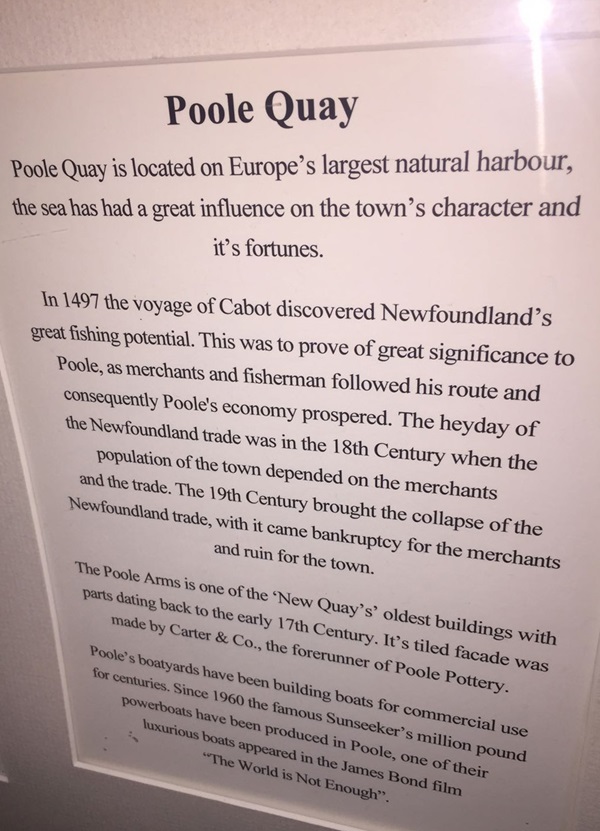
The text reads: Poole Quay is located on Europe’s largest natural harbour, the sea has had a great influence on the town’s character and its fortunes.
In 1497 the voyage of Cabot discovered Newfoundland’s great fishing potential. This was to prove of great significance to Poole, as merchants and fisherman followed his route and consequently Poole’s economy prospered. The heyday of the Newfoundland trade was in the 18th century when the population of the town depended on the merchants and the trade. The 19th century brought the collapse of the Newfoundland trade, with it came bankruptcy for the merchants and ruin for the town.
The Poole Arms is one of the New Quay’s oldest buildings with parts dating back to the early 17th century. Its tiled façade was made by Carter & Co, the forerunner of Poole Pottery.
Poole’s boatyards have been building boats for commercial use for centuries. Since 1960 the famous Sunseeker’s million pound powerboats have been produced in Poole, one of their luxurious boats appeared in the James Bond film The World is Not Enough.
Prints and text about Canford Manor.
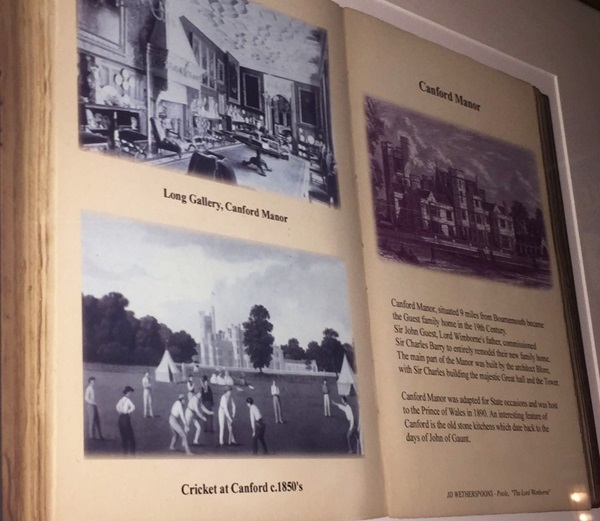
The text reads: Canford Manor, situated 9 miles from Bournemouth became the Guest family home in the 19th century.
Sir John Guest, Lord Wimborne’s father, commissioned Sir Charles Barry to entirely remodel their new family home. The main part of the Manor was built by the architect Blare, with Sir Charles building the majestic Great Hall and the Tower.
Canford Manor was adapted for State occasions and was host to the Prince of Wales in 1890. An interesting feature of Canford is the old stone kitchens which date back to the days of John of Gaunt.
A photograph and text about Poole Public Library.

The text reads: In February 1887 the Sheriff called a public meeting to decide how the town should commemorate the Queen’s Jubilee. The meeting was well attended and a great deal of public interest was shown for the two proposed projects: Lord Wimborne’s hospital or John Norton’s free library.
At the end of the meeting it was decided by an overwhelming vote in favour of the public library and school of art.
The town’s Sites Committee finally met 9 weeks later and the council asked for Lord Wimborne’s help in finding a suitable site for the library. Feeling no animosity to his rejection he offered to sell them a piece of his land off the High Street for £100. The council accepted, but by this time Norton was furious with the slow developments and in frustration he wrote a letter to the mayor. His patience with the committee was exhausted due to the lack of progress during the past four and half months.
His near impossible deadline to complete the building by that September had caused him to take the matter into his own hands; he would now build it himself.
Under Norton’s supervision the library was completed in 5 months, employing 125 workmen to construct the “Free Classic in red brick and stone” building. They worked around the clock using enormous electric lights and on 29 September 1887, Norton sent the keys of the library to the mayor.
An illustration and text about John J Norton.

The text reads: John J Norton was born in Hampshire on the 27 October 1843. His family moved to Poole when he was 11 and from 1854-72 he was employed at a lath cleaving establishment on the West Shore. During that time he saved sufficient funds to enable him to start his own business, from small beginnings his business grew and prospered and his commercial life was one of a great success.
On the 9 November 1886 Mr John Norton wrote a letter to the mayor of Poole stating he “had a desire to see a building erected for a public library” and he would be prepared to expend £1,000 for the purpose of building a free library, reading rooms, and if possible a school of art.
The offer was subject to conditions, the following are few of them:
1. That a suitable site be obtained by way of gift purchase or exchange.
2. That a reading room for women should be provided.
3. That a clause should be inserted in the Deed of Gift absolutely prohibiting the sale of intoxicating liquor;
4. That the building should be completed ready for use by the 29 September 1887.
His offer was accepted and to thank him for his generosity he was made as honorary freeman of the borough and Sheriff of Poole during 1870-80.
He had been a lifelong total abstainer and died on the 16 April 1930, aged 86.
An illustration and text about the history of Poole.
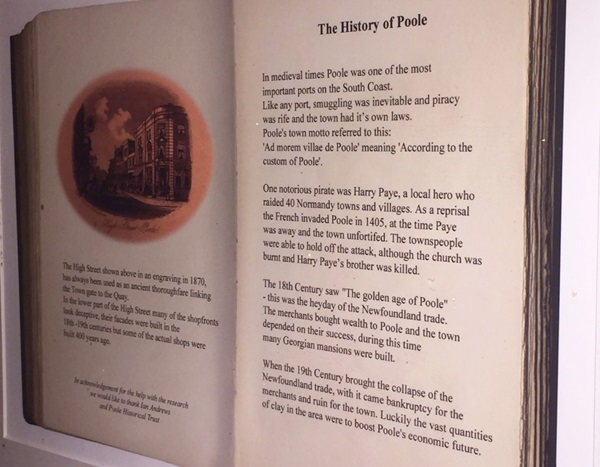
The text reads: The High Street above in an engraving in 1870, has always been used as an ancient thoroughfare linking the town gate to the Quay.
In the lower part of the High Street many of the shopfronts look deceptive, their facades were built in the 18th and 19th centuries but some of the actual shops were built 400 years ago.
In medieval times Poole was one of the most important ports on the South Coast. Like any port, smuggling was inevitable and piracy was rife and the town had its own laws.
Poole’s town motto referred to this:
‘Ad morem villae de Poole’ meaning ‘According to the custom of Poole’.
One notorious pirate was Harry Paye, a local hero who raided 40 Normandy towns and villages. As a reprisal the French invaded Poole in 1405, at the time Paye was away and the town unfortified. The townspeople were able to hold off the attack, although the church was burnt and Harry Paye’s brother was killed.
The 18th century saw “The golden age of Poole” – this was the heyday of the Newfoundland trade. The merchants bought wealth to Poole and the town depended on this success, during this time many Georgian mansions were built.
When the 19th century brought the collapse of the Newfoundland trade, with it came bankruptcy for the merchants and ruin for the town. Luckily the vast quantities of clay in the area were to boost Poole’s economic future.
Illustrations and text about the history of Poole potteries.
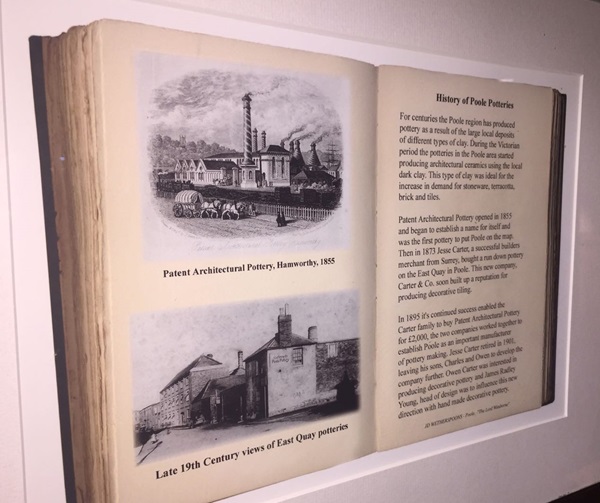
The test reads: For centuries the Poole region has produced pottery as a result of the large local deposits of different types of clay. During the Victorian period the potteries in the Poole area started producing architectural ceramics using the local dark clay. This type of clay was ideal for the increase in demand for stoneware, terracotta, brick and tiles.
Patent Architectural Pottery opened in 1855 and began to establish a name for itself and was the first pottery to put Poole on the map. Then in 1873 Jesse Carter, a successful builders merchant from Surrey, bought a rundown pottery on the East Quay in Pool. This new company, Carter & Co soon built up a reputation for producing decorative tiling.
In 1895 its continued success enabled the Carter family to buy Patent Architectural Pottery for £2,000, the two companies worked together to establish Poole as an important manufacturer of pottery making. Jesse Carter retired in 1901, leaving his sons, Charles and Owen to develop the company further. Owen Carter was interested in producing decorative pottery and James Radley Young, head of design was to influence this new direction with handmade decorative pottery.
Old signage for potteries in Poole.



Signage to show that these buildings were erected and presented to the Borough of Poole as a free library by John J Norton.
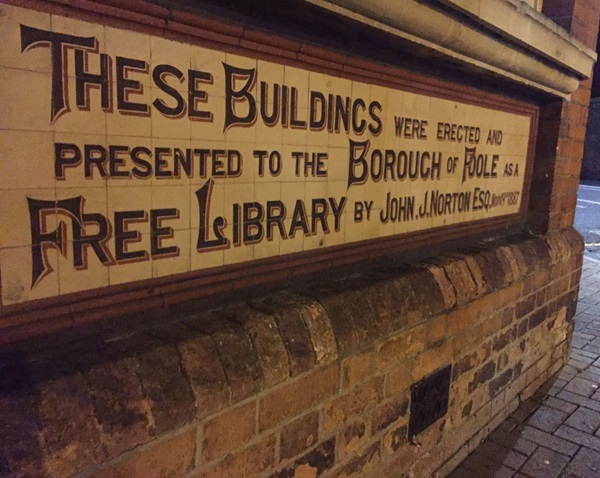
External photographs showing some of the original library design features.
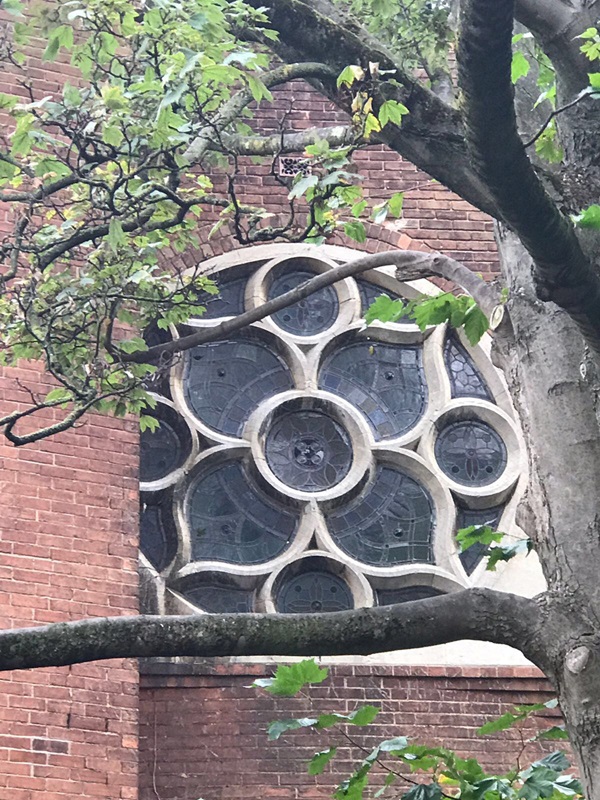
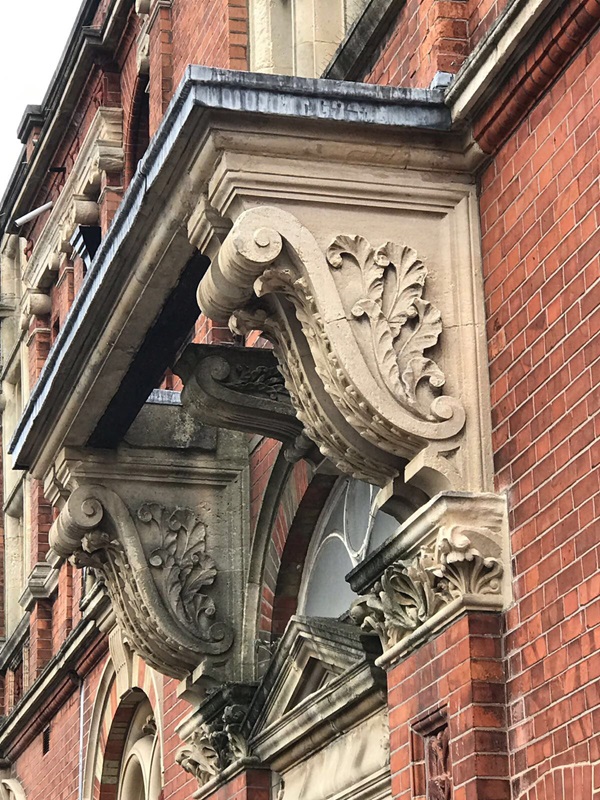

External photograph of the building – main entrance.

If you have information on the history of this pub, then we’d like you to share it with us. Please e-mail all information to: pubhistories@jdwetherspoon.co.uk